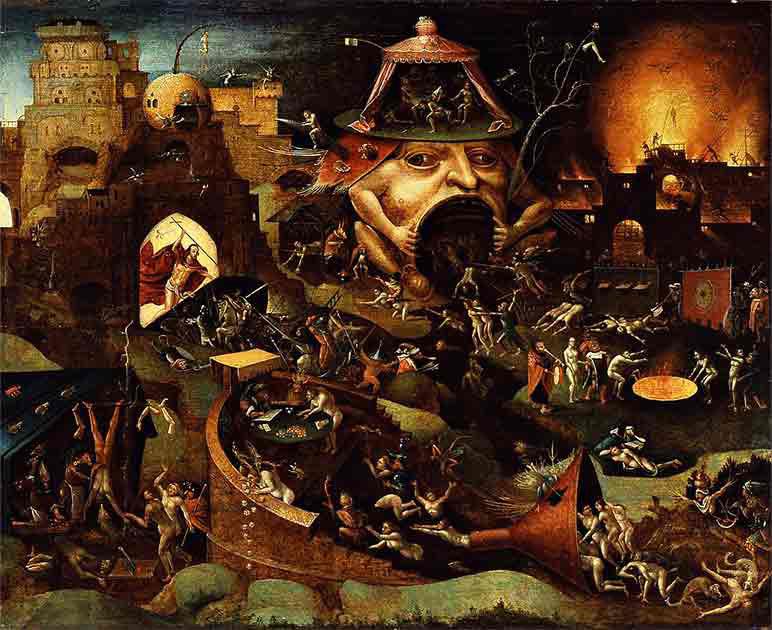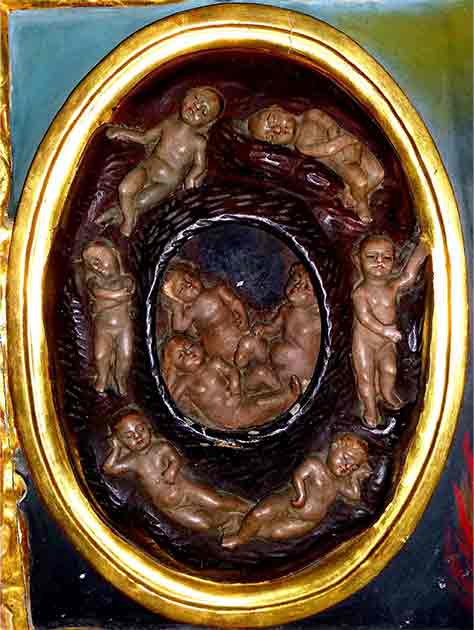There are a lot of core concepts of Christianity that are not in the Bible. Many of these crystallized out of centuries of learned discourse from Catholic church leaders, aided by their erudite knowledge but also aided by the fact that their flock could not read Latin, and therefore fact checking was not available.
Some of these discussions revolved around the Bible, to be sure, and the enormous import of what could be gleaned from it. Umberto Eco’s novel The Name of the Rose takes place amidst a discussion between delegates from the Pope and Franciscan monks as to whether Jesus owned his clothing: the fabulously wealthy Papal representatives said he did, and therefore all their possessions had divine precedent, but the parsimonious Franciscans begged to differ.
But some creations were pretty much entirely extra-Biblical. This is the case for Limbo, the weird halfway house between heaven and hell where souls would lurk, not for eternity, but to await the arrival of Christ and with the prospect of eventually getting into heaven.
While currently not a formal doctrine of the Catholic Church, it has been a topic of theological speculation and pastoral concern throughout the history of Christianity. After all, it is an inevitable conclusion of what we are told about life after death in the Bible.
But where did it come from, and how did it grow into the concept we see today?
A Way to Manage Sin
The term “Limbo” derives from the Latin word “limbus,” meaning “edge” or “boundary.” It was developed to describe the state of those souls who, not meriting damnation, were also not allowed into the presence of God in Heaven. Historically, Limbo has been considered in two main contexts: Limbo of the Fathers (Limbus Patrum) and Limbo of the Infants (Limbus Infantium).
Limbo of the Fathers refers to the state of the righteous who died before Christ’s salvific death and resurrection. According to Catholic theology, these good souls, who through no fault of their own were born and died before Christ, could not enter Heaven until the redemption wrought by Christ opened its gates.
- Dogma: Seven Central Tenets of Catholicism with Zero Biblical Support
- Patron Saints: Your Afterlife Advocate for Almost Anything
This concept is rooted in scriptural references, notably 1 Peter 3:19, which speaks of Jesus preaching to the “spirits in prison”. And from this scant Biblical evidence sprang an entire tangled web of theology and debate.
Medieval artists, starting from this position, have made some pretty wild extrapolations about what Limbo must be like. Many depict these souls as essentially in hell, awaiting the coming and their rescue by Christ.

Limbo of the Infants, on the other hand, is very different and concerns the fate of unbaptized infants. The necessity of baptism for salvation was affirmed by Jesus in the Gospel of John (3:5), leading theologians to ponder the eternal destiny of infants who died without this sacrament.
Augustine of Hippo (354-430) had a lot to say about this, associating original sin with damnation and necessitating baptism for salvation. However, recognizing the harshness of condemning innocent infants to hell, the theory of Limbo emerged as a state of natural happiness, devoid of the Beatific Vision. Nobody wants to send babies to hell, after all.
The theological underpinnings of Limbo therefore rest on two pillars: original sin and the necessity of baptism. According to Catholic teaching, all human beings inherit original sin from Adam and Eve, which separates them from God. Baptism is believed to erase original sin, restoring the individual’s relationship with God and opening the path to Heaven.
For centuries, theologians grappled with the justice of God in the context of unbaptized infants. Limbo was theorized as a solution that upheld the justice of God while also demonstrating His mercy.
Souls in Limbo would not suffer the punishments of hell but would also not enjoy the Beatific Vision, the direct encounter with God in Heaven. Babies who died before baptism were not damned for eternity; instead they had to wait for the day of salvation.
Advancing the Theory
Over the centuries, the concept of Limbo underwent various reinterpretations and debates among theologians as the centuries went by. The Council of Florence (1439) and the Council of Trent (1545-1563) both looked at the problem, wrestling with issues related to the concept of salvation and how baptism interacted with original sin, but neither definitively settled the question of Limbo.

In the 20th century, the Second Vatican Council (1962-1965) and subsequent Papal teachings began to shift the emphasis from a judgmental understanding of salvation (sinners go to hell, the righteous will get into heaven in the end) towards a more nuanced appreciation of God’s mercy. This evolution reflected a broader theological and pastoral reevaluation of traditional concepts, including Limbo.
But still the idea stuck, floating around the edges of Catholic theology. Ancient dead people needed somewhere to wait until the coming of Christ, and that place, for want of a better name, was called Limbo.
- Swoon or Substitute? Two Rationalizations of the Resurrection of Jesus
- The Sacro Catino: Did Napoleon break the Holy Grail?
The most significant recent development regarding Limbo came with the publication of “The Hope of Salvation for Infants Who Die Without Being Baptized” by the International Theological Commission in 2007. While not an official document of the Magisterium, it was approved for publication by Pope Benedict XVI and reflects a significant evolution in the Church’s approach to the topic.
The document suggests that there are theological and liturgical reasons to hope that infants who die without baptism may be saved and enjoy the Beatific Vision. It emphasizes God’s mercy and the universality of Christ’s salvific mission, suggesting that God might have ways of bringing these souls to salvation that are not fully revealed to us.

This development does not formally abolish the concept of Limbo but represents a move away from its necessity in Catholic theology. It underscores the Church’s trust in God’s mercy and the hope that all might be saved, especially those who have no personal sin.
The concept of Limbo in Catholicism has been ultimately a matter of theological speculation rather than defined doctrine. It emerged as a way to reconcile the justice and mercy of God in the salvation of souls, particularly concerning the righteous before Christ and unbaptized infants.
Over time, the Church’s understanding and teaching on this topic have evolved, reflecting a deeper appreciation for God’s mercy and the mystery of salvation. The contemporary Catholic stance, emphasizing hope and trust in God’s mercy for those who die without baptism, marks a significant pastoral and theological shift, encouraging a more inclusive view of salvation that relies on the infinite love and justice of God.
And what is it like in Limbo? Do righteous souls experience the passage of time, surrounded by screaming newborns and growing ever more frustrated at the delay? Are they temporarily burning in hell, waiting for Christ to come set them free?
That is a whole new can of theological worms.
Top Image: Christ in Limbo. Source: Follower of Jheronimus / Public Domain.
By HM Editorial Staff